3″ Director In-Ceiling Loudspeakers Manual
Install Guide:
Introduction
Thank you for purchasing the Director 3” In-Ceiling Speaker.
At Origin Acoustics, we take pride in providing you with a high quality product. All of Origin Acoustics’ speakers are designed to have excellent sound quality, longevity, and a simple installation process.
These instructions covers the necessary information for a smooth installation, including: the tools you will need, step-by-step instructions for installation, troubleshooting tips for any errors that may occur, and all warranty information. If for any reason you experience problems or if you have installation questions please call us at (844) 674-4461. Hours of operation are 8:00am to 5:00pm (Pacific Time), Monday through Friday.
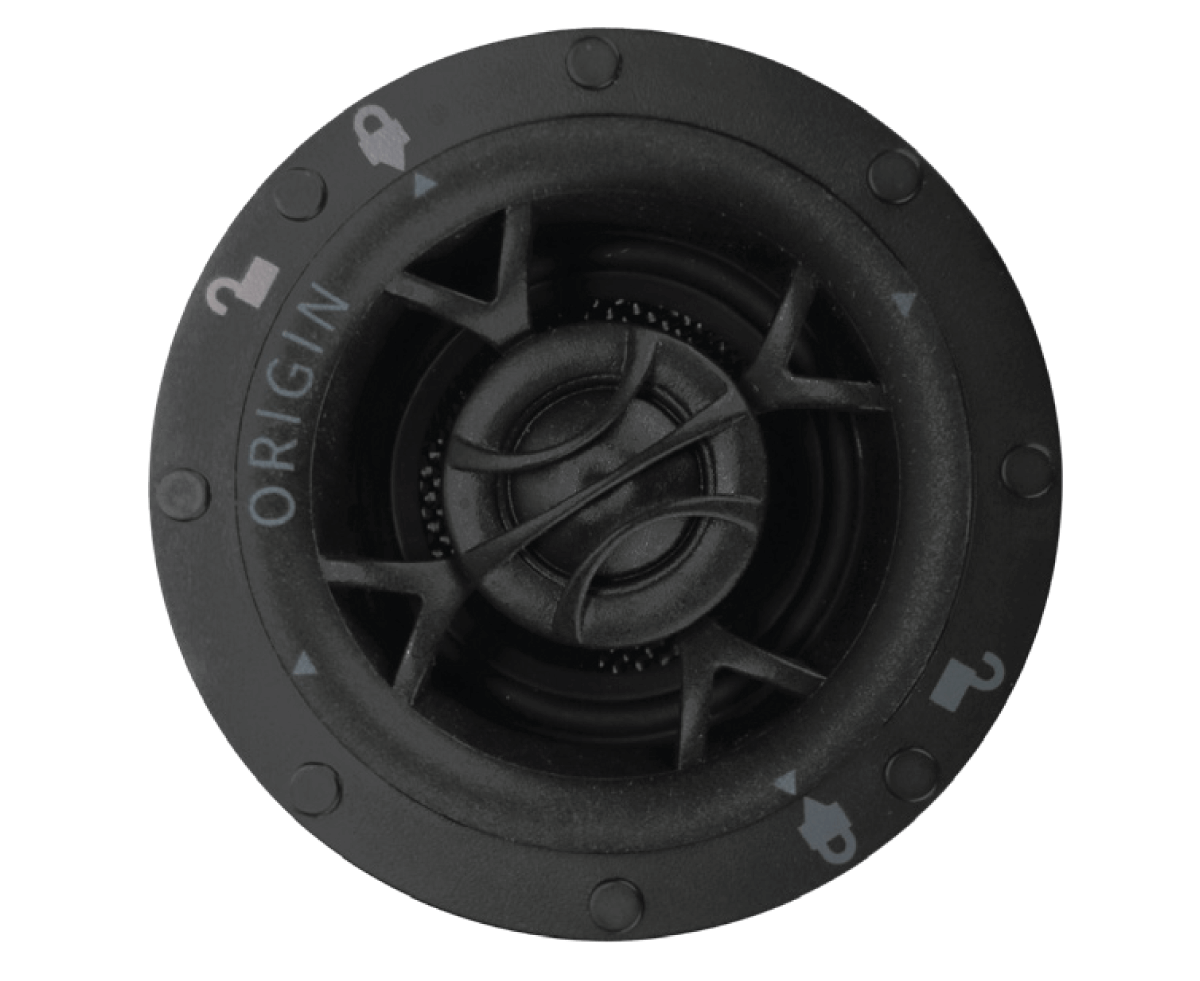
What's Included

A) BAYONET RING To be inserted within in-ceiling hole
B) BAYONET RAILS The Zip-KlipsTM Grips are raised & lowered along these rails.
C) ZIP – KLIPTM GRIPS Provide secure grip against drywall. Use 2 finger grooves to pull down and lower. (Zip-Klip™ Mounting System, Patent #9591390)
D) RELEASE TABS Press BLACK tabs inwards to release grip and raise Zip-KlipTM.
E) LOCKING GROOVES Used to ALIGN speaker inside Bayonet Ring.
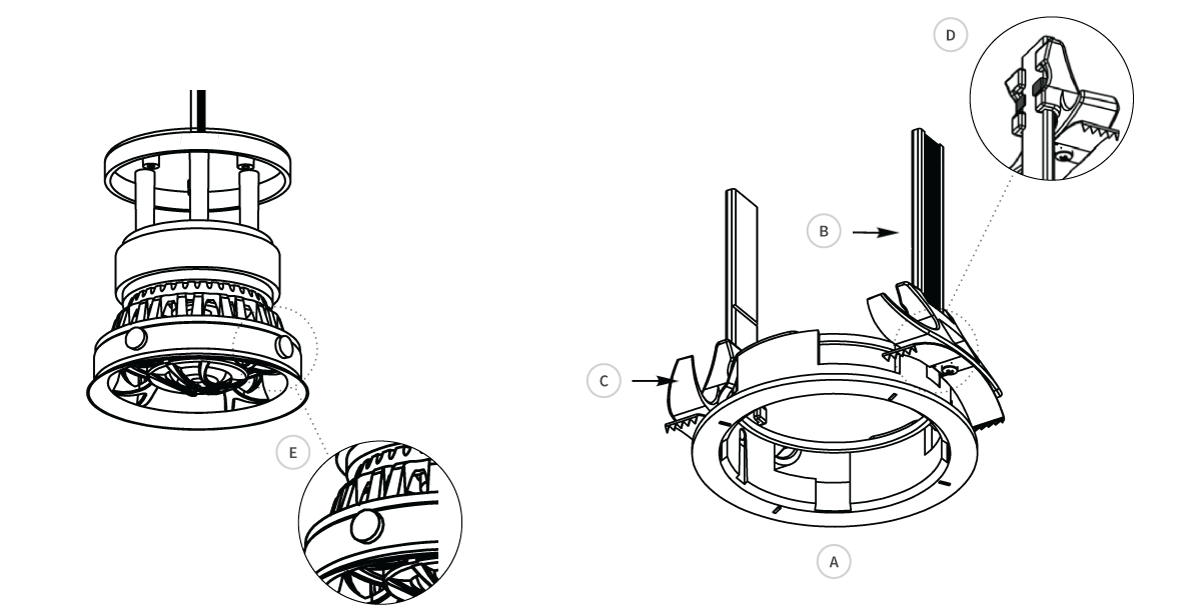
Required Tools
-
Drywall Saw
-
Speaker Wire
-
Pencil
-
Wire Stripper
-
Measuring Tape
-
Drill
-
Drill Bit ⅛” (3mm)
-
Stiff Wire
-
Stud Finder
-
Fish Tape
-
Spray Paint
-
Compressed Air
Recommended Speaker Wire
The gauge of wire used can have an impact on the performance of your speakers. Use a multi-stranded wiring designed for amplifier to speaker connections. Which gauge to select depends on the length of wire to be used on any particular speak–er. The longer your run is, the larger your wire size must be.
| WIRE LENGTH | WIRE GAUGE |
|---|---|
| 0 -100’ (0 - 30m) | 16 |
| 50 - 150’ (15 - 45m) | 14 |
| Over 100’ (30m) | 12 |
System Wiring Options
Single DSP Amplifier
4 x D39 Speakers & 1 x Subwoofer
There are several ways to configure the Director 3” speakers. Our recommended option is to use the DSP3-150 amp, to easily run the entire system setup off this single amplifier, designed for best performance. Alternatively, there are also a few options, using dedicated amplifiers for the speakers and subwoofers, (such as our SubA150 and DSP2-200):
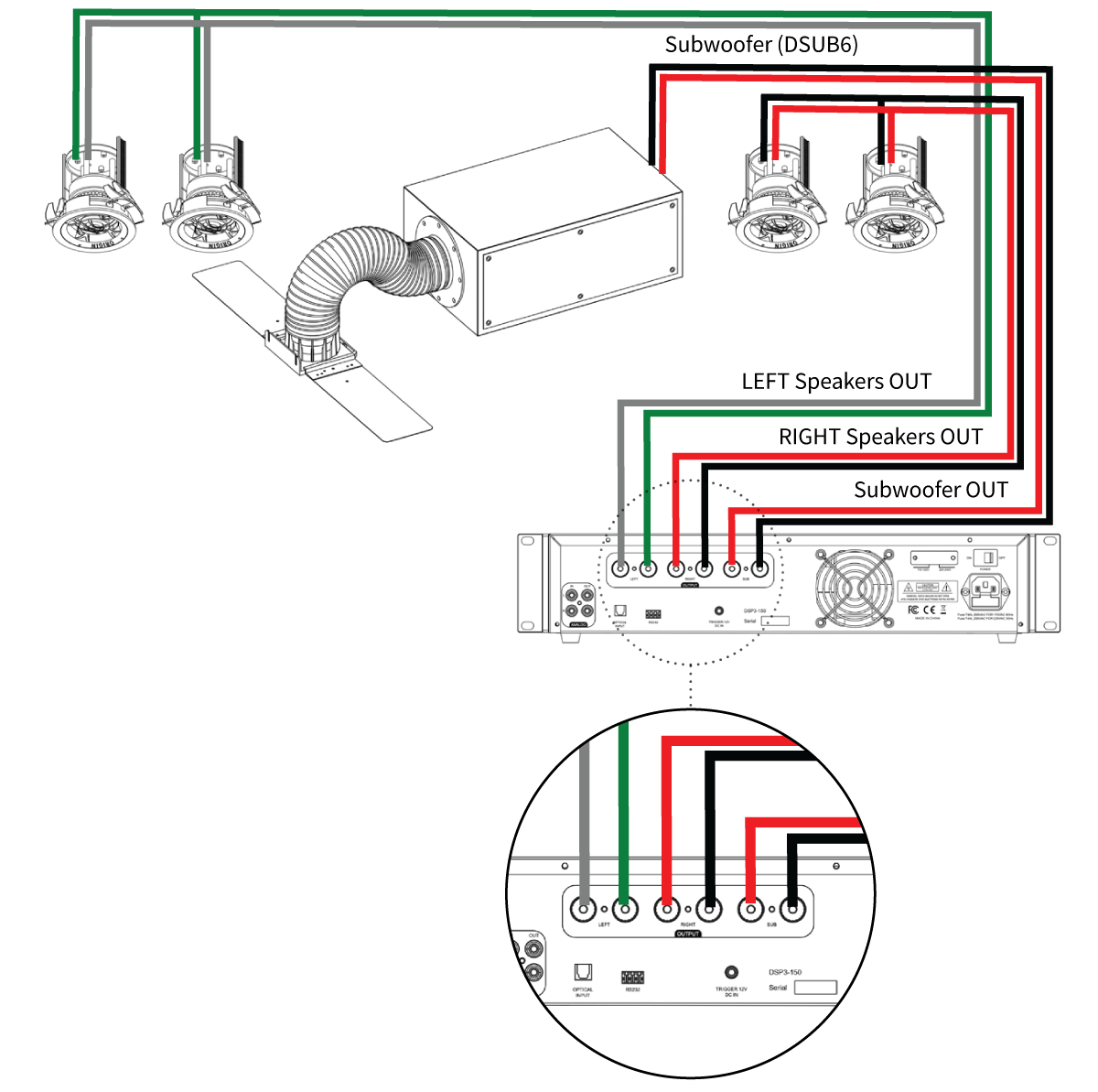
4 x D39 Speakers & 1 x Subwoofer with DSP3-150 Amp
2 Channel Amplifier + Subwoofer Amplifier:
4 – 8 D39 Speakers & 1 – 2 Subwoofers
With 4-Ohm stable amplifiers, you can use up to four Director 3” Speakers per channel. If you’re using the Origin DSUB6 with the D39 speakers, we recommend our SubA150 or SubA500 for the subwoofer. For the speakers in this set up, we recommend the DSP2-200 Amp as the dedicated 2-Channel amp for the speakers.

4 – 8 D39 Speakers & 1 – 2 Subwoofers
2 Channel Amplifier:
4 x D39 Speakers & 1 x DSUB6 Subwoofer
For a setup with four speakers and one subwoofer, a 2-Channel amp, such as the recommended the DSP2-200 Amp, can be used. First, both amplifier outputs should be connected to the DSUB6 subwoofer’s L/R inputs. From there the subwoofer has L/R outputs to connect to the D39 speakers. Each output can be connected up to 2 speakers in parallel (4 speakers total plus the subwoofer).

4 x D39 Speakers & 1 x DSUB6 Subwoofer

Speaker Wire Installation Guidance
Use a two-conductor wire that allows you to identify one conductor from the other. This designation may be obvious or as subtle as a ridge on one conductor.
It’s crucial that you keep track of which wire you use for positive (+) and negative (-). Typically if the wires are colored red and black, the red wire is used for positive and the black wire is used for negative, but sometimes other colors or patterns are used. You can choose whichever color of wire you want to be positive and negative as long as you remain consistent throughout the install.
On both your amplifier and your speaker the connectors will be identified as red for positive and black for negative. It is very important to look carefully at the speaker wires and be certain that the same wire that is attached to the positive connector in the amplifier is attached to the positive connector in the speaker.
Installing the Speaker Wire
Strip ¼ to ½ inches (6 to 12 mm) of the insulation off both ends of the wire. To avoid stray strands, twist them at the end. Connect the wire to the amplifier, and make sure the wire connected to the left speaker output will be routed to the left speaker, right output to right speaker, etc.

Wire Routing
Plan how you will route the wire to the desired speaker location. There are several methods for routing the wire, and you may need to combine several of them.
Behind the Baseboard
The wire can be routed behind the baseboard by cutting a groove out of the back of the baseboard, or by buying a special baseboard designed for concealing wires.
Attic or Basement
When available, you can route the wire through an attic or crawlspace.
Through Walls
When running wires through a wall, be sure to avoid all obstacles such as AC wiring, pipes, and ducts.
Under the Carpet
One option is to lift up the carpet and route “tape wire” under the carpet.
For New Construction
If these speakers are being installed in a new home during construction, the installation process will be a bit different (although much simpler). For these situations, it is recommended you purchase a bracket. Instructions on how to install the speakers are provided with the bracket, or can be found on our website. Visit www.originacoustics.com for more information.
Cutting the Hole
When you’ve decided on the locations for all of the speakers, use the Cut-Out Template to trace a circle lightly in pencil where the hole should be. (If you don’t have a template, check the Specifications section for cutout sizes). If you’re unsure on whether there may be obstacles (such as pipes or wires) where you plan on installing the speaker, drill a ⅛ inch hole in the center of the circle, then put a bent coat hanger through the hole to feel around. Use a keyhole or drywall saw to cut the hole.

Installation Guidance
Removal of Speaker from Bayonet Ring
The Speaker will arrive securely in its Bayonet Ring. To release the speaker, follow these steps

Twist the Speaker COUNTER- CLOCKWISE, so that the arrow on the Speaker Rim, aligns to the “UNLOCKED” Symbol along the Bayonet Ring. Now the Speaker should be unlocked from the ring. Use caution to remove the speaker from the Bayonet Ring, without forcing the lock mechanism.
Installing Bayonet Ring Into Ceiling
1) Gently bend the Zip-Clip™ rails inwards from the top, just enough, so they fit through the ceiling hole opening, then insert the Bayonet Ring into the Cut-Out hole within the ceiling surface.
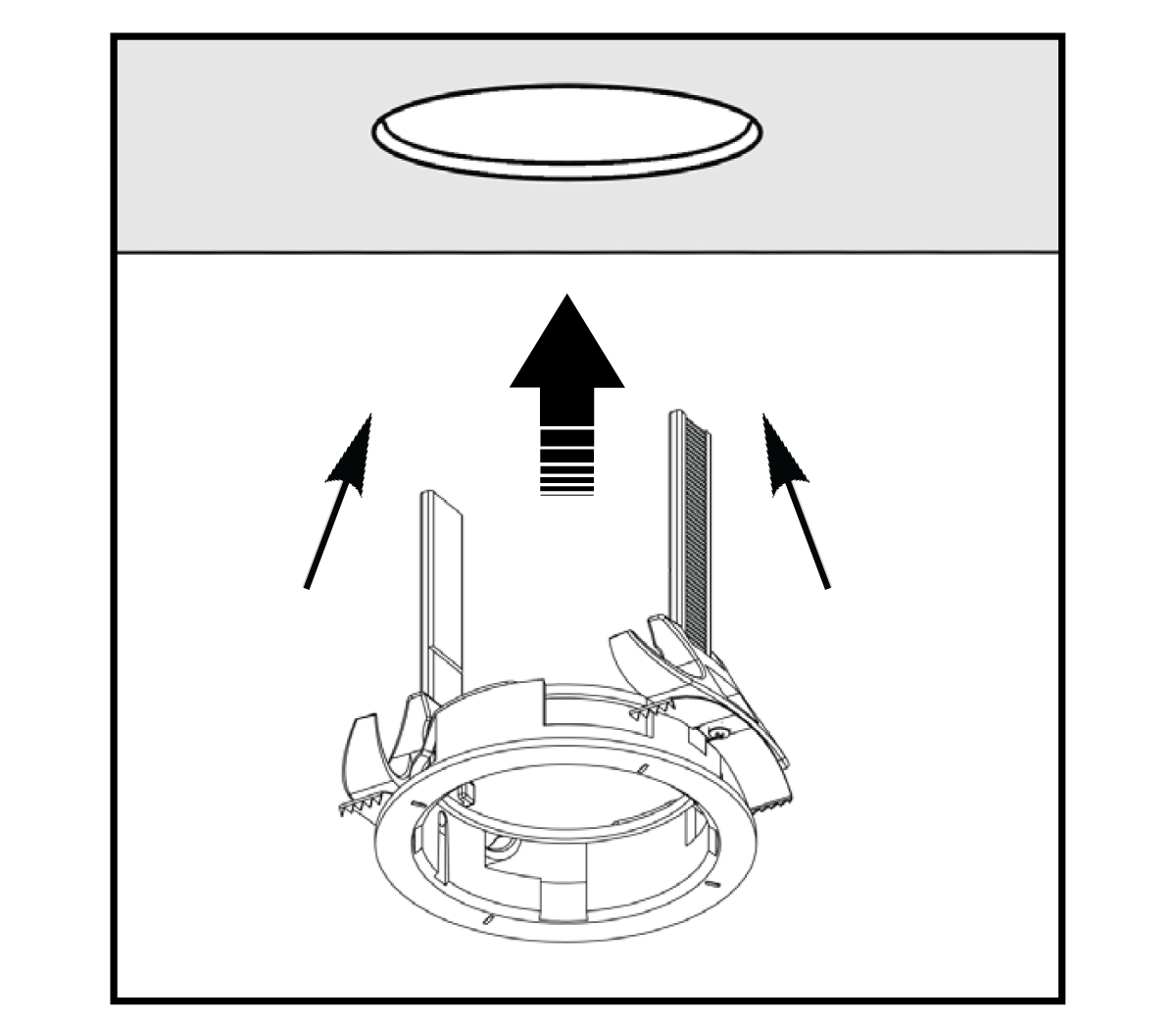
2) Reach inside the Bayonet Ring, placing 2 fingers on the grooves of the Bayonet Zip-ClipTM to pull each Zip-ClipTM down the rail, until it grips the drywall securely. The Bayonet Ring should be firmly in place, but not too tight.
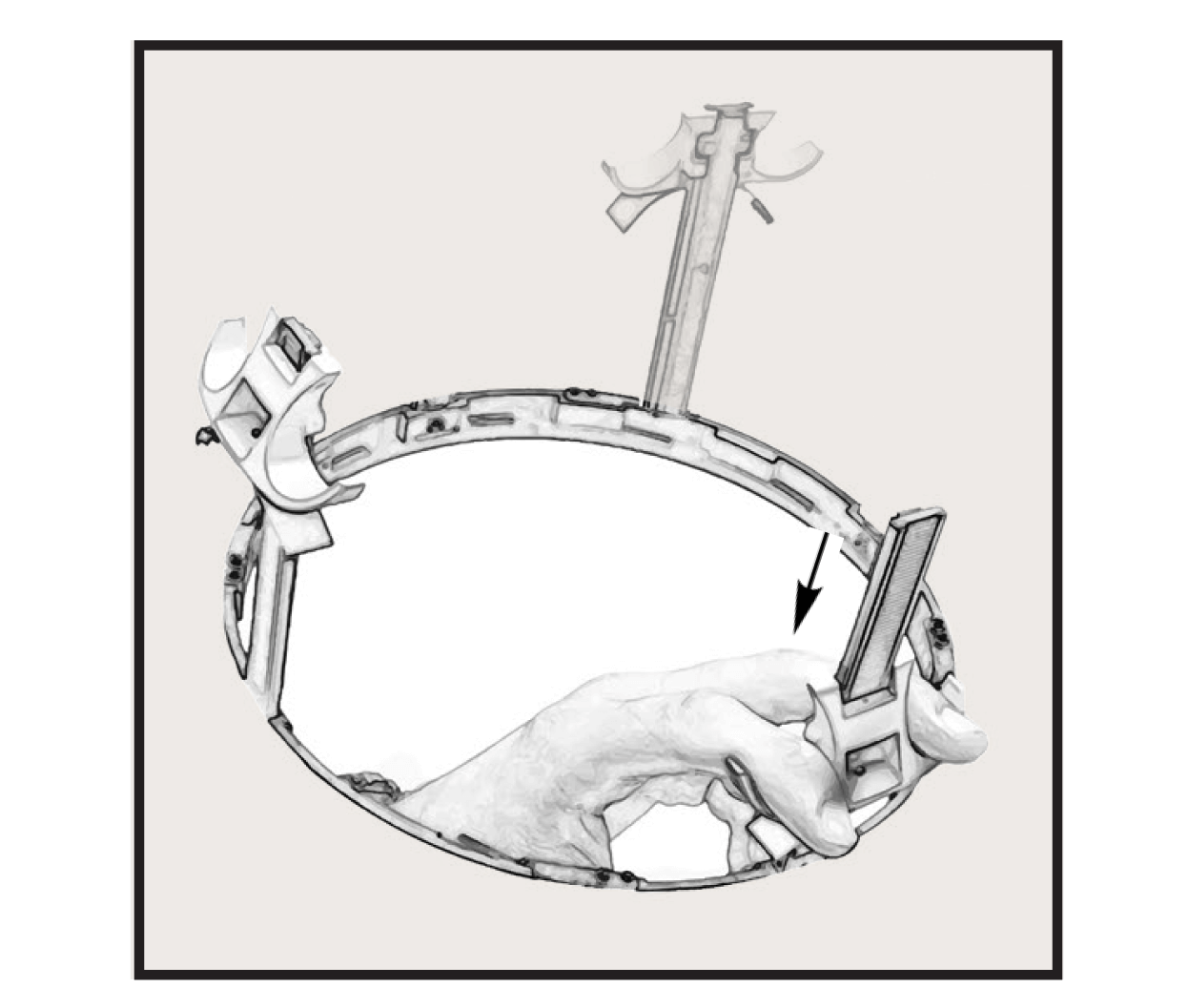
3) Pull down on BOTH Bayonet Zip-ClipsTM to lower them along the Bayonet rails.
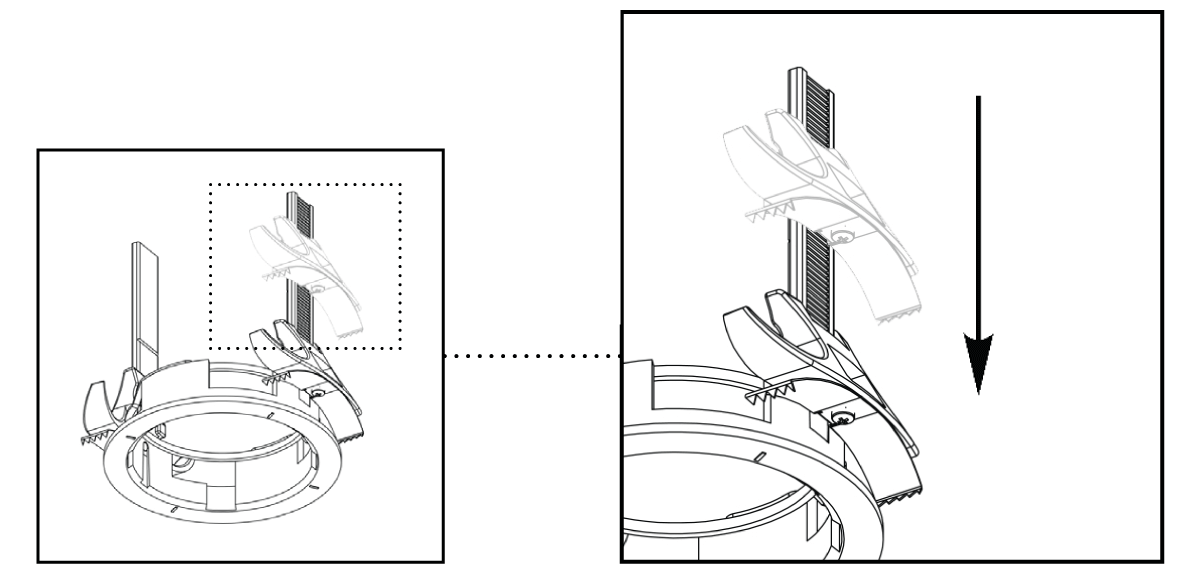
Release Bayonet Ring From Ceiling

NOTE: IF THE BAYONET RING NEEDS TO BE REMOVED, OR THE ZIP-CLIPSTM NEED TO BE ADJUSTED:
Depress the metal tabs on the inside of each Zip-ClipTM, while pushing /sliding the Zip-ClipTM upwards along the rail to reset the clip.
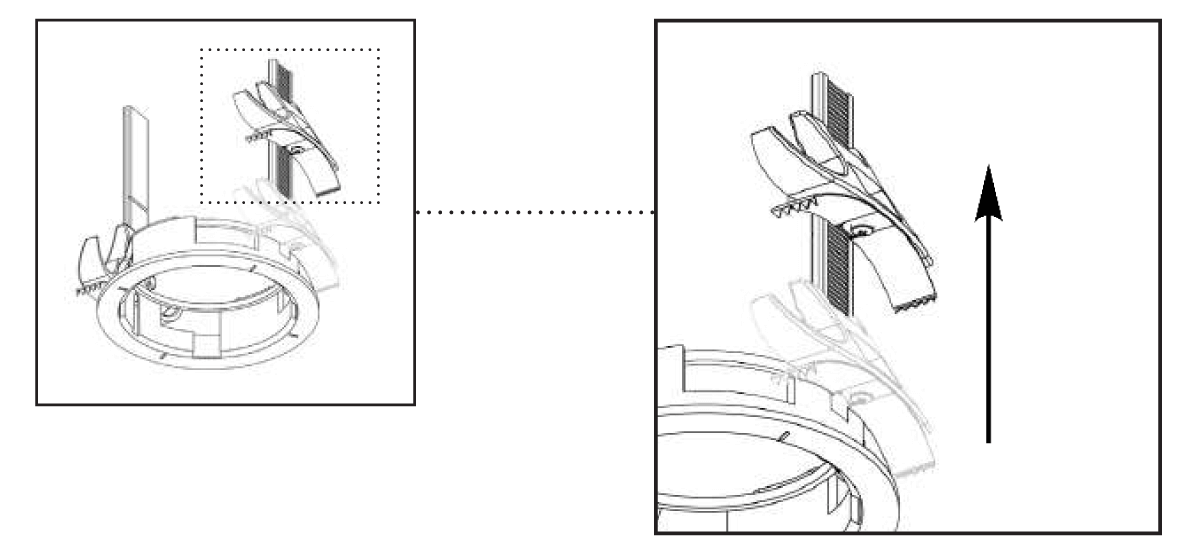
Connecting the Speaker Wire
Take the ceiling speaker wire and connect it to the Terminal Connector on the Speaker. Push down on each connector, and insert each wire into the opening with the correct polarity. Make sure that the positive wire is attached to the red connection and the negative wire is being attached to the black connection. If the wires are switched, speaker performance will be drastically impacted.
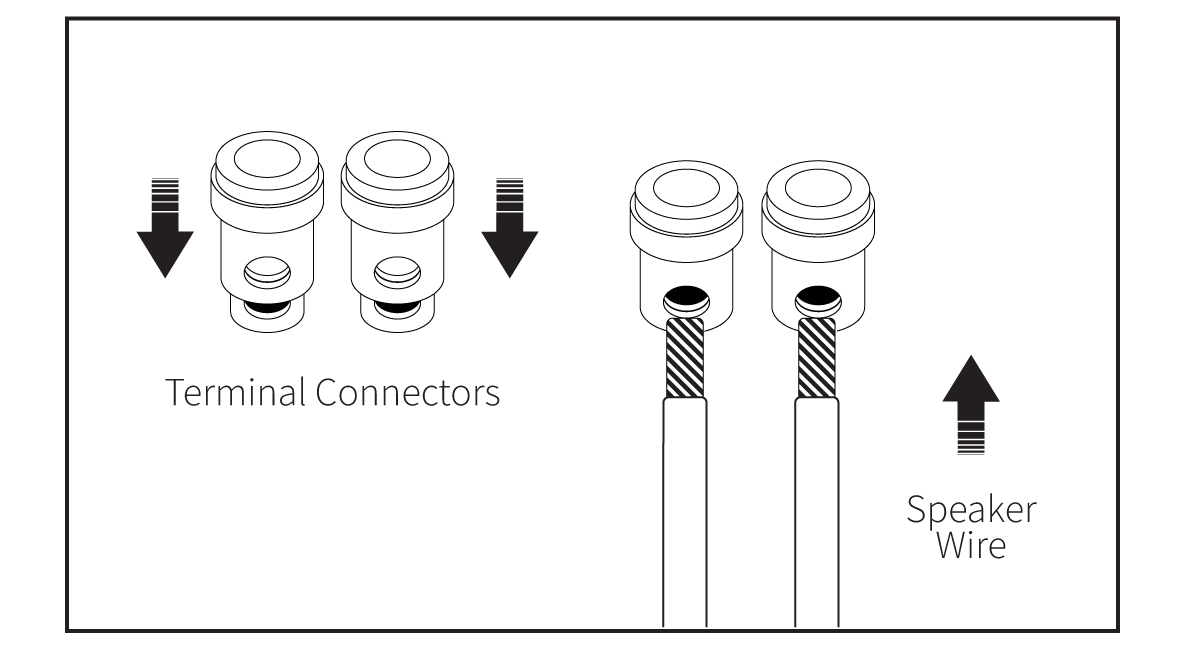
Installing Speaker Into Bayonet Ring
1) After connecting speaker wires:
Insert the Speaker into the Unlocked Bayonet Ring
Fit the Speaker into the Bayonet Ring, with the arrows on the Speaker Rim aligning to the “UNLOCKED” Symbol along the Bayonet Rim.
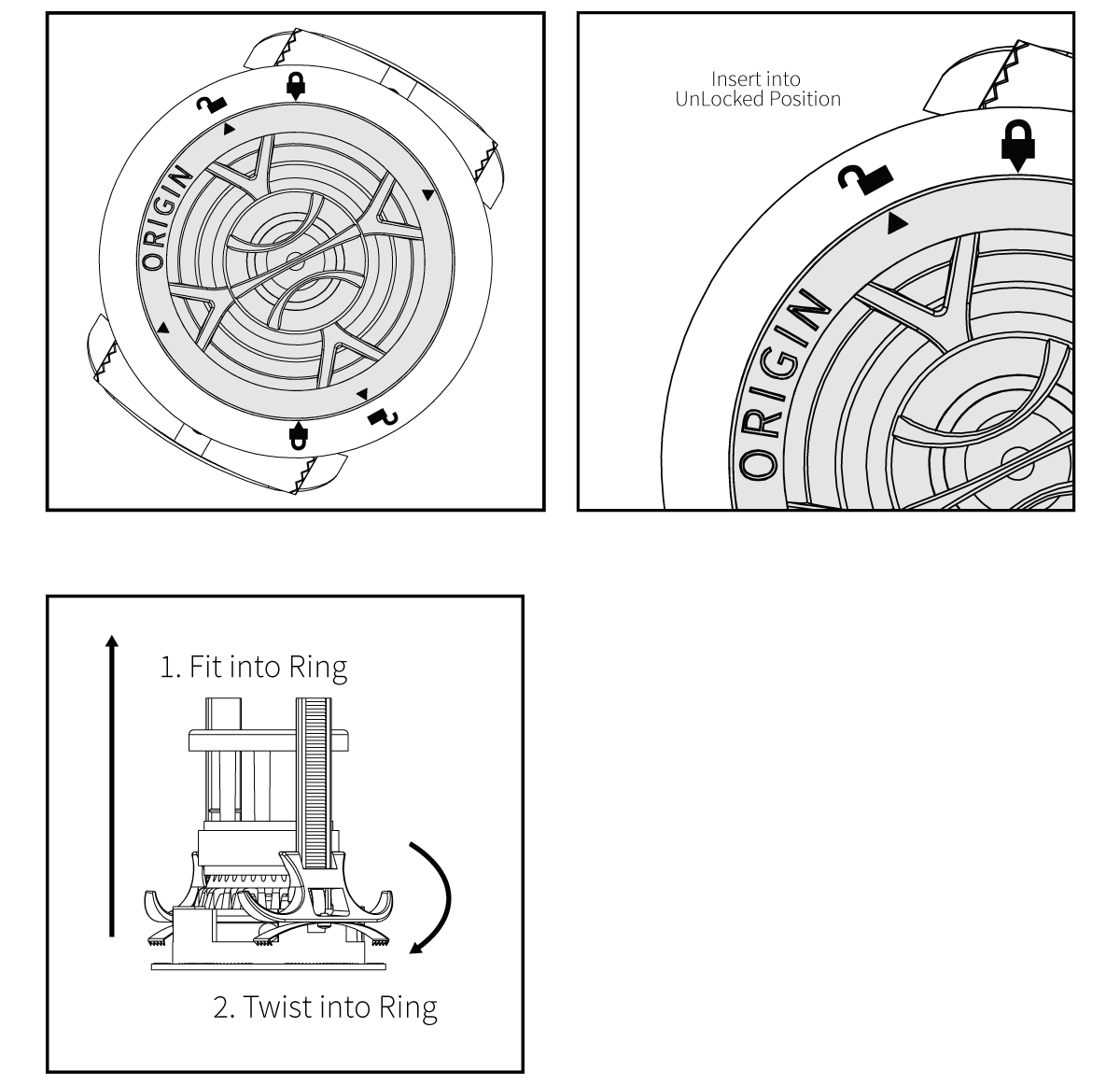
Twist the Speaker Clockwise
Twist the Speaker CLOCKWISE, so that the arrow on the Speaker Rim slots into place, aligning to the “LOCKED” Symbol along the Bayonet Ring.
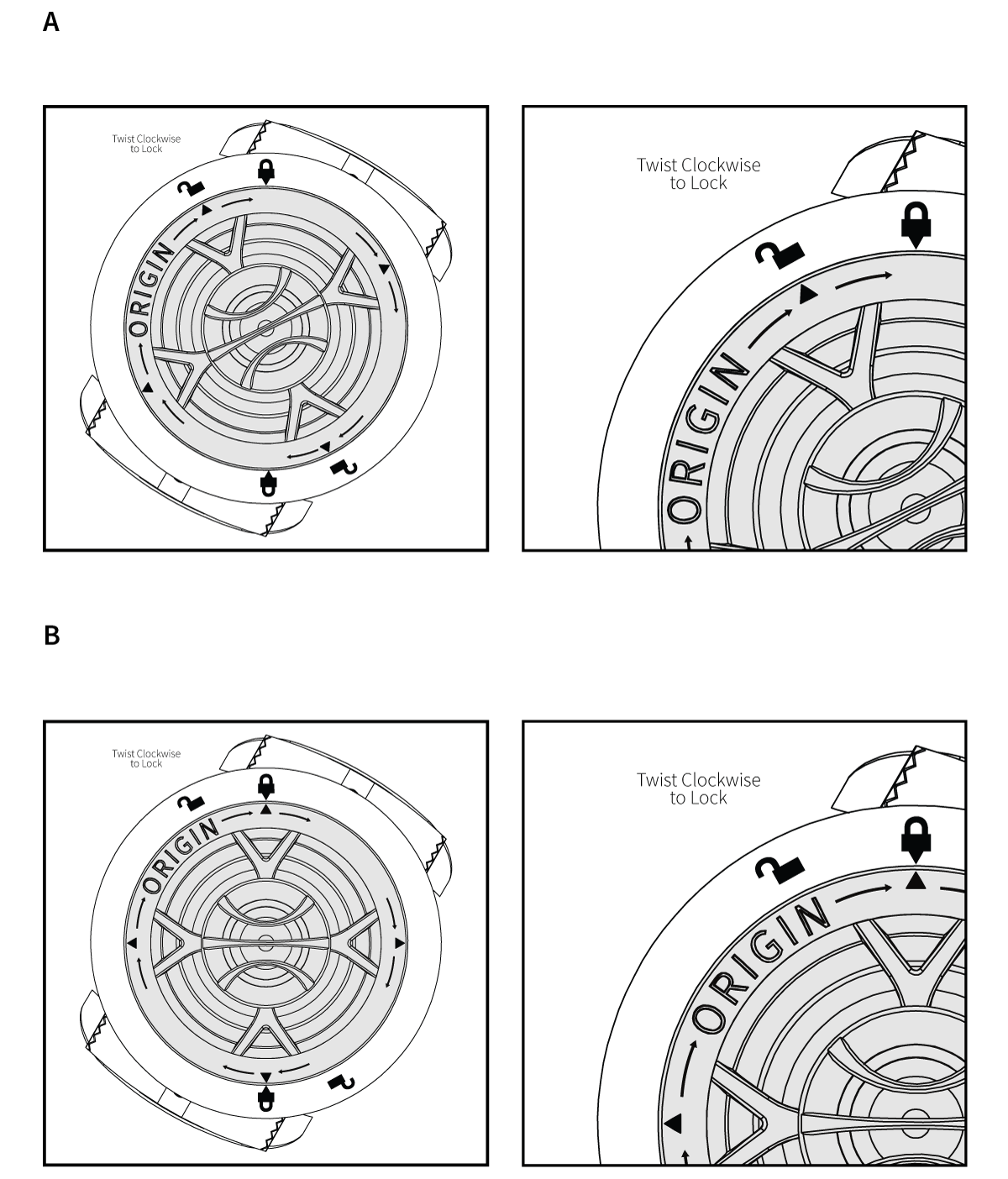
Ensure the Speaker is Locked
Now the Speaker should be securely locked into the ring. Be sure that the arrows line up correctly, otherwise there’s a risk that the speaker will fall out of the ceiling.
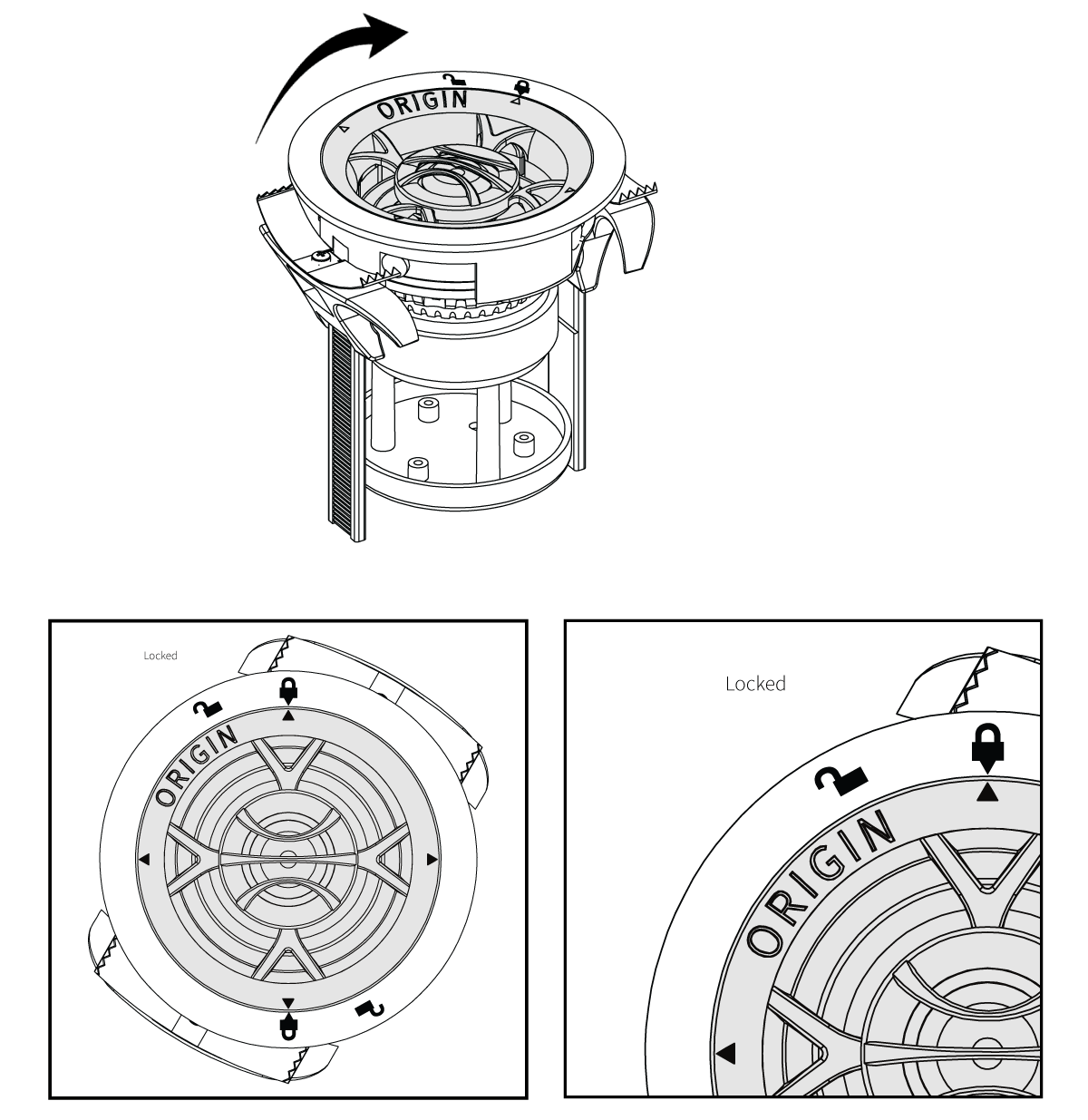
Adding the Grille
Installing the Grille
The magnetic grille easily fits over the speaker. Square replacement grilles are also available for purchase separately.
Painting the Grille
In some situations the speakers may look better if the color matched the walls, ceiling, or trim in the room. This can be accomplished by painting the grille. The grille must be painted with spray paint, and most hardware stores will mix a can of paint to match whatever color you need. Before painting, carefully remove the thin cloth on the underside of the grille. Lightly spray the front of the grille with the paint from a distance, being careful not to plug any of the holes. Diluting the paint with paint thinner will lessen the risk of filling any holes. If a hole gets plugged use a can of compressed air to open it. Once the paint is dry, put the cloth back on the grille.
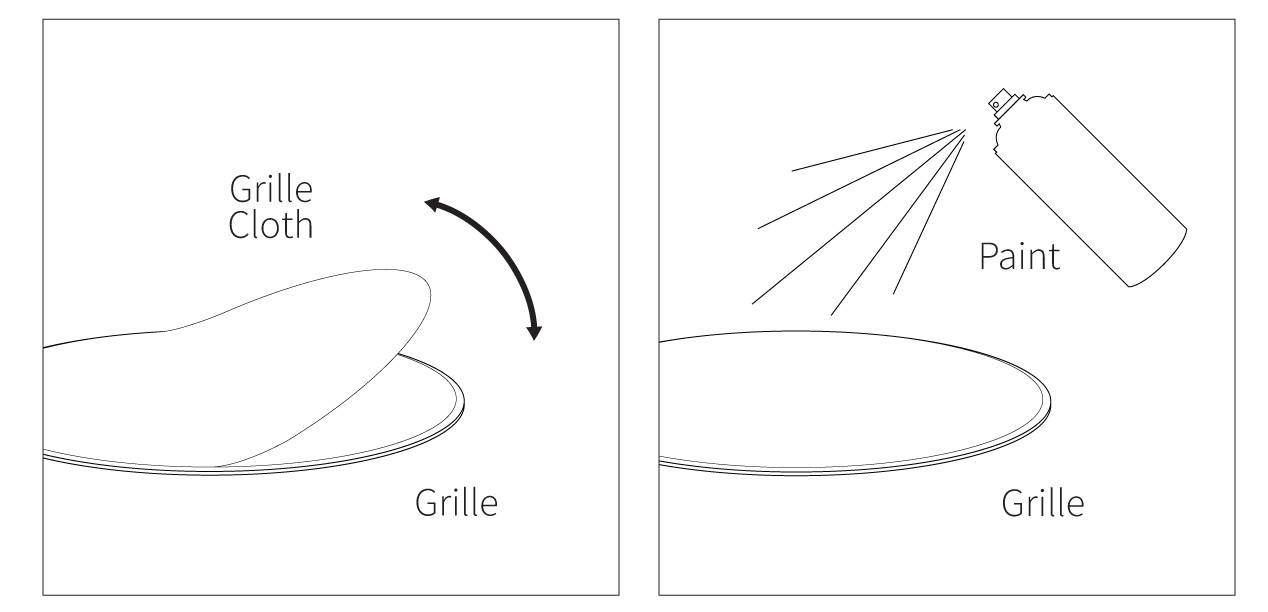
Troubleshooting
If you have a problem, try isolating it first. For example, if you’re playing a DVD and there is no sound, try replacing the DVD with an MP3 player to see if you get sound. If it does work, then the problem is with the television, DVD player, or the cables connecting them. If it doesn’t work, the problem will be with the amplifier, speakers, or those cables.
Common Solutions
| PROBLEM | POSSIBLE CAUSES |
|---|---|
| NO SOUND | The volume may be turned down or muted. Check the volume settings volume may be turned down or muted. Check the volume settings on both the amplifier and the DVD player/ television/ computer/ etc. |
| NO SOUND | Make sure the proper source is selected on the amplifier or receiver. |
| NO SOUND | Check the cord connecting the amplifier with the source. The cord may be damaged or plugged into the wrong input or output. |
| NO SOUND | Check the wires connecting the amplifier with the speakers. Make sure they’re connected properly and not damaged in any way. |
| POOR SOUND QUALITY | If you hear something like static, or the sound is cutting in and out, check the audio cables. If the problem increases when a cable is being moved, then the cable is most likely faulty or not connected properly. |
| POOR SOUND QUALITY | Today’s audio systems may have several places to adjust the volume, for example your MP3 player may have a volume control, and your amplifier may also have one. Check to be certain that the volume isn’t turned up past 80% on any device. |
| POOR SOUND QUALITY | Try changing sources to be certain that the selection you’ve chosen is a good quality recording. |
Technical Assistance
If you have any questions or concerns about installing or using this product, you can reach us through one of the following methods:
Phone: (844) 674-4461
Hours of operation: 8:00am – 5:00pm (Pacific Time), Mon – Fri
Email: sales@originacoustics.com
If you are having technical trouble, please include the model number and briefly explain what steps you took to resolve the problem in your email, or be prepared to answer these questions over the phone. If you are considering returning the product, it’s required that you contact Origin Acoustics prior to any return attempts. This way we can determine if the issue can be resolved without returning the product, or if needed we can provide instructions and support for the return process.
Limited Lifetime Warranty
Origin Acoustics warrants to the original retail purchaser only that this Origin Acoustics product will be free from defects in materials and workmanship, provided the speaker was purchased from an Origin Acoustics authorized dealer.
If the product is determined to be defective, it will be repaired or replaced at Origin Acoustics’ discretion. If the product must be replaced yet it is no longer manufactured, it will be replaced with a model of equal to or greater value that is the most similar to the original. If this is the case, installing the replacement model may require mounting modifications; Origin Acoustics will not be responsible for any such related costs.
Requirements & Coverage
This warranty may not be valid if the product was purchased through an unauthorized dealer. This warranty only applies to the individual that made the original purchase, and it cannot be applied to other purchases. The purchaser must be prepared to provide proof of purchase (receipt). This warranty will not be valid if the identifying number or serial number has been removed, defaced, or altered.
Not Covered by Warranty
- Accidental damage
- Damage caused by abuse or misuse
- Damage caused by attempted repairs/modifications by anyone other than Origin Acoustics or an authorized dealer
- Damage caused by improper installation
- Normal wear, maintenance, and environmental issues
- Damage caused by voltage inputs in excess of the rated maximum of the unit
- Damage inflicted during the return shipment
Return Process
Before making any return attempts, it is required that you first contact Origin Acoustics. Return product to Origin Acoustics or your dealer, either in person or by mail. It’s preferable if the product is returned in the original packaging. If this isn’t possible, the customer is responsible for insuring the shipment for the full value of the product.
This warranty is in lieu of all other expressed or implied warranties. Some states do not allow limitations on implied warranties, so this may not apply depending on the customer’s location. (For more information, see Magnuson-Moss Warranty Act.)
| D39 | |
| Part: | SCD30900 |
| Tweeter: | ¾” Silk DPSD™ |
| Midrange: | N/A |
| Woofer: | 3” Kevlar® |
| Frequency Response: | 100Hz-20kHz |
| Power RMS: | 30 Watts |
| Power Peak: | 100 Watts |
| Impedance: | 10Ω |
| Mounting Depth: | 3 ¹⁵⁄₁₆” (100mm) |
| Cutout Diameter: | 3 ¼” (83mm) |
| Speaker Diameter: | 3 ¹⁵⁄₁₆” (100mm) |
| Grille Diameter: | 4 ¼” (108mm) |
| Grille Depth: | ⅛” (3mm) |